Mighty Enlil Of The Sumerian Pantheon Of Gods
A. Sutherland - AncientPages.com - Ancient Sumer had a very complex pantheon of gods and goddesses, but four of these powerful figures played an important role because they were creators of everything.
Enlil (EN.LIL – his name meant "lord of the airspace" or “the air-god”) was the king of earth and heaven.
According to Sumerian beliefs, Enlil arrived on Earth well before the human race was created. He was Anu's eldest son; these two share the same epithets in different ancient texts, which describe Enlil -the second in the triad of Sumerian supreme gods – as "The Great Mountain" or "King of All the Lands" (lugal-kur-kur-ra) and “Father of the Gods.
Enlil's role in is based on Enlil’s power and authority is clearly emphasized in the Mesopotamian mythology; he creates and destroys and is the "decreer of fates".
He has the right to rule the world and to give kingship to kings and rulers, who turn to him to verify their claims to power. Enlil himself announces the king's name and awards him the scepter - a sign of his favor and acknowledgment.
He had placed gods on earth, arranged dwellings and cult places for them, which were not to be changed. Each god owned a special territory, which included a house, a temple to live in and priests to serve him. Enlil’s holy city of Nippur was called “built on its own”.
One example is mentioned in “The Lament for Urim” when Enlil is said to have "brought the storm of abundance away", to have "annihilated the land, silenced the city" (ETCSL 2.2.2).
As the "Lord of abundance", Enlil is a provider, but at the same time, this great authority could also take such plenty away from people and devastate the land.
Although Anu had authority over the pantheon of Sumer, Enlil was even more powerful as he embodied energy and force. He was also the god of agriculture, who separated earth and heaven to give the place for planet’s seeds to grow. He designed the plans to bring all trees, plants, and seeds to people on Earth.
 According to one myth, Enlil raped his consort Ninlil (Sud, in a Sumerian myth), the goddess of grain.
According to one myth, Enlil raped his consort Ninlil (Sud, in a Sumerian myth), the goddess of grain.
Despite the fact that Sumerian gods were powerful they were obliged to follow certain rules. Even the supreme god, Enlil, was once punished for his transgressions and exiled to the underworld.
Enlil’s cult center was at Nippur, the city located in central southern Mesopotamia and dedicated to him; his great sanctuary, the E.KUR ("house which is like a mountain") was also located at Nippur. In the divine area of Nippur, Enlil had his court, where he met with the gods for assembly.
As the “Lord of Destinies”, Enlil was the keeper of the “Tablet of Destiny”, which was stolen from him the evil bird-god Zu, who knew that the wearer of this tablet had the full control of the universe and fates of all.
In the Akkadian sources, Enlil’s nature is often described as malevolent and his “… command no god can set aside”. However, many disagree with this description of the mighty Enlil. Contrary to the common belief, Enlil was not a destructive deity who intended to harm to people. Instead, he was given the task to bring destruction and misfortune when it was required and decided by the Pantheon’s gods.
Many ziggurats devoted to Enlil existed in different locations such as Assur, Babylon, Dur-Kurigalzu and, probably, in Elam, outside of Mesopotamia.
Written by – A. Sutherland AncientPages.com Staff Writer
Copyright © AncientPages.com All rights reserved. This material may not be published, broadcast, rewritten or redistributed in whole or part without the express written permission of AncientPages.com
Expand for referencesReferences:
E. Wilshire, Insight into Two Biblical Passages
R.G. Kratz,H. Spieckermann, One God – One Cult – One Nation: Archaeological and Biblical Perspectives
More From Ancient Pages
-
 Stone Age Europe Had Nine Distinct Cultures – Ancient Jewelry Reveals
Archaeology | Feb 3, 2024
Stone Age Europe Had Nine Distinct Cultures – Ancient Jewelry Reveals
Archaeology | Feb 3, 2024 -
 Strange Ancient Measurements Of The Earth Revealed – Ancient Texts And Physical Evidence Examined
Featured Stories | Apr 11, 2018
Strange Ancient Measurements Of The Earth Revealed – Ancient Texts And Physical Evidence Examined
Featured Stories | Apr 11, 2018 -
 Historian Suggests Jack The Ripper Fled To Australia Where He Met His End
Archaeology | Sep 10, 2016
Historian Suggests Jack The Ripper Fled To Australia Where He Met His End
Archaeology | Sep 10, 2016 -
 Cryptic Ice Age Markings In European Caves Deciphered – Proto-Writing Discovered By Amateur Archaeologist
Archaeology | Jan 5, 2023
Cryptic Ice Age Markings In European Caves Deciphered – Proto-Writing Discovered By Amateur Archaeologist
Archaeology | Jan 5, 2023 -
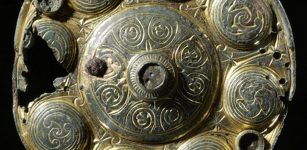 Viking’s Symbols Of Travels Prestige And Adventure Were Imported From Abroad
Ancient Symbols | Oct 1, 2015
Viking’s Symbols Of Travels Prestige And Adventure Were Imported From Abroad
Ancient Symbols | Oct 1, 2015 -
 Controversial Unexplained Ancient Mystery In Mongolia – Horrifying Sight – Part 2
Featured Stories | May 2, 2018
Controversial Unexplained Ancient Mystery In Mongolia – Horrifying Sight – Part 2
Featured Stories | May 2, 2018 -
 Krakatoa Prophecy – Samson’s Mysterious Dream
Featured Stories | Aug 6, 2019
Krakatoa Prophecy – Samson’s Mysterious Dream
Featured Stories | Aug 6, 2019 -
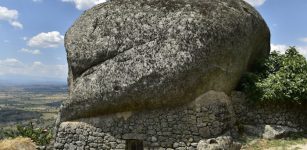 Ancient Village Of Monsanto, Miraculously Balanced Giant Boulders And Knights Templar Connection
Civilizations | Dec 20, 2018
Ancient Village Of Monsanto, Miraculously Balanced Giant Boulders And Knights Templar Connection
Civilizations | Dec 20, 2018 -
 ‘Reforms of Shang Yang’ – Location Of Ancient Yueyang – Confirmed
Archaeology | Jan 25, 2016
‘Reforms of Shang Yang’ – Location Of Ancient Yueyang – Confirmed
Archaeology | Jan 25, 2016 -
 On This Day In History: Noah Webster, Jr. “Father Of American Scholarship And Education” Was Born – On Oct 16, 1758
News | Oct 16, 2016
On This Day In History: Noah Webster, Jr. “Father Of American Scholarship And Education” Was Born – On Oct 16, 1758
News | Oct 16, 2016 -
 Mystery Of Human Evolution – What Can Ancient Genes Tell Us About Who We Are?
Archaeology | Jun 2, 2022
Mystery Of Human Evolution – What Can Ancient Genes Tell Us About Who We Are?
Archaeology | Jun 2, 2022 -
 People Who Carry Neanderthal Gene Variants Have Greater Pain Sensitivity
DNA | Oct 11, 2023
People Who Carry Neanderthal Gene Variants Have Greater Pain Sensitivity
DNA | Oct 11, 2023 -
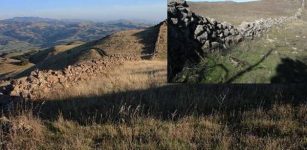 Mystery Of Great Wall Of California: An Ancient Unsolved Enigma
Civilizations | Sep 11, 2018
Mystery Of Great Wall Of California: An Ancient Unsolved Enigma
Civilizations | Sep 11, 2018 -
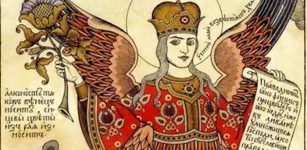 Alkonost – Mythical Bird Of Paradise In Slavic And Russian Folklore
Featured Stories | Jul 6, 2020
Alkonost – Mythical Bird Of Paradise In Slavic And Russian Folklore
Featured Stories | Jul 6, 2020 -
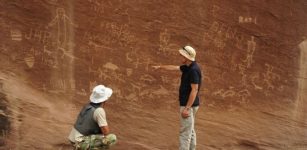 Archaeologists Discover Previously Unknown Huge Galleries And Petroglyphs In Colorado
Archaeology | Dec 15, 2023
Archaeologists Discover Previously Unknown Huge Galleries And Petroglyphs In Colorado
Archaeology | Dec 15, 2023 -
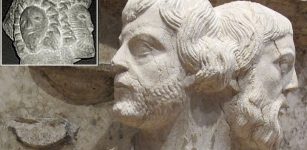 Two-Faced Great Roman God Janus – Symbol Of All Beginnings And Endings
Featured Stories | Apr 9, 2021
Two-Faced Great Roman God Janus – Symbol Of All Beginnings And Endings
Featured Stories | Apr 9, 2021 -
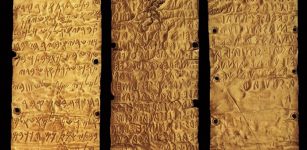 Pyrgi Gold Tablets: A Rare Ancient Bilingual Treasure
Artifacts | Nov 23, 2018
Pyrgi Gold Tablets: A Rare Ancient Bilingual Treasure
Artifacts | Nov 23, 2018 -
 Are The Ten Commandments Based On The Forty-Two Principles Of Maat That Appeared 2,000 Years Earlier?
Biblical Mysteries | Jul 15, 2017
Are The Ten Commandments Based On The Forty-Two Principles Of Maat That Appeared 2,000 Years Earlier?
Biblical Mysteries | Jul 15, 2017 -
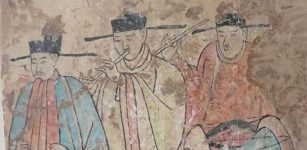 Ancient Fresco Tomb Dated A 1000-Years Ago Was Accidentally Discovered In Northern China
Archaeology | May 5, 2020
Ancient Fresco Tomb Dated A 1000-Years Ago Was Accidentally Discovered In Northern China
Archaeology | May 5, 2020 -
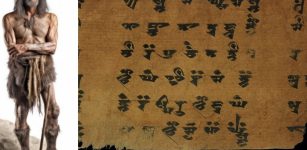 Ancient European Languages Shed Light On A Great Migration And Weather Vocabulary
Archaeology | Aug 14, 2023
Ancient European Languages Shed Light On A Great Migration And Weather Vocabulary
Archaeology | Aug 14, 2023


